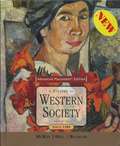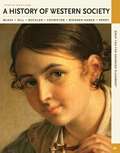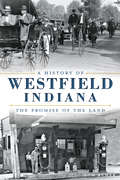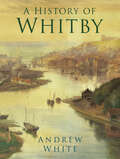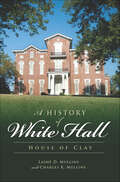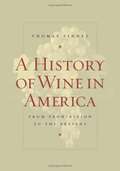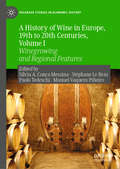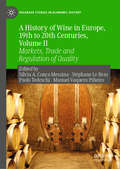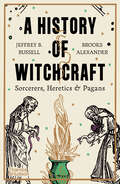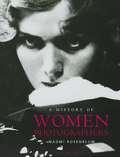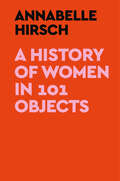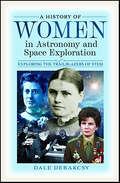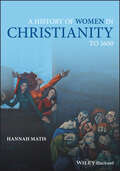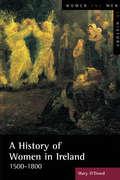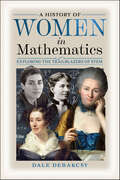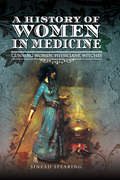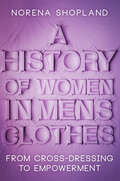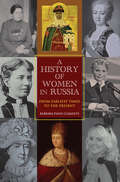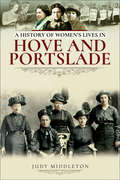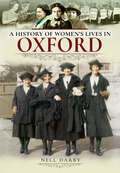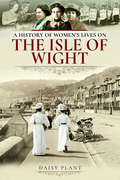- Table View
- List View
A History of Western Society: Since 1300
by John Buckler John P. Mckay Bennett D. HillNIMAC-sourced textbook
A History of Western Society: Since 1300 For Advanced Placement
by John Buckler John P. Mckay Bennett D. Hill Clare Haru Crowston Merry E. Wiesner-Hanks Joe PerryA History of Western Societyremains the most popular AP European history textbook available because it captures students' interest in the everyday life of the past and ties social history to the broad sweep of politics and culture. The tenth edition has been thoroughly revised to strengthen the text's readability, heighten its attention to daily life, and incorporate the insights of new scholarship, including a strengthened treatment of European exploration and a thoroughly revised post-1945 section. With a dynamic new design, new special features on visual evidence, and a completely revised and robust companion reader, this significant revision will help AP students master the concepts and content of European history.
A History of Westfield, Indiana: The Promise Of The Land (Brief History)
by Tom RumerFounded in 1834 by a small group of Quakers protesting human slavery in the South, Westfield and Washington Township served as an important home station on the Underground Railroad. Shortly after black emancipation, residents rallied to promote racial equality and harmonious living, helping to curtail the clout of the Ku Klux Klan. Van Camp Company, once the largest local employer, provided pork and beans for thousands of troops entrenched in World War I, and the community's strong agricultural tradition sustained the town through the Great Depression. Author and historian Tom Rumer chronicles the challenges of growth and change in this history of Westfield and Washington Township.
A History of Whitby
by Andrew WhiteWHITBY is well known today as a seaside resort and a picturesque place to visit, with its piers, boats, fine sands and, overlooking its tangle of red-roofed houses, the ruins of its Abbey in one of the most splendid settings in Britain for such romantic remains. But few of its many visitors would guess the long history of the town or its significance, from time to time, in national affairs. Its fine natural harbour, one of the few on the east coast, gave it early importance as a place of refuge and a fishing port. By the mid-7th century a royal monastery was established on the east cliff. Ruled for many years by the famous Abbess Hilda, it was destroyed by the Vikings, then rebuilt by the Norman, Reinfrid. The Middle Ages saw quiet growth but the 17th century brought great prosperity, with shipbuilding on a scale out of all proportion to its size, serving the coal trade between the Tyne and the Thames, with many of the sturdy ‘colliers’ built and owned here; and the rapid growth of whaling, with similar implications. Indeed, Captain Cook’s four ships, used on his great voyages of exploration, were all built here. Long isolated, except by sea, Whitby developed a very distinctive set of traditions and folklore. Not until a horse-drawn railway was built in the 1830s did Whitby’s inland communications improve, bringing visitors for whom hotels and boarding houses were built on the west cliff. Queen Victoria made Whitby jet fashionable, while the town’s geology brought trade in alum and in superbly preserved fossils. Largely derived from its unusual past, the town’s unique character draws thousands of visitors each year; and the first edition of this book, in 1993, was as much welcomed by them as by the locals. The only comprehensive history of Whitby, it rapidly sold out and Dr White, its author, of ancient Whitby stock, has now fully revised and updated his book, with some new illustrations and interpretations. This new edition will continue as the definitive work on the town, as well as a very entertaining story.
A History of White Hall: House of Clay (Landmarks)
by Lashé D. MullinsIn 1799, Revolutionary War veteran General Green Clay finished construction on a stately Georgian mansion he named Clermont. The home became a statewide symbol of prosperity, housing the farm of one of the largest landowners in the Commonwealth. Renamed White Hall by Cassius Marcellus Clay and renovated by his wife, Mary Jane Warfield Clay, it remained in the family for generations. Here Cassius Clay became known as the "Lion of White Hall," penning his fiery speeches against slavery and launching his tumultuous career as an outspoken statesman. After years of restoration, White Hall became a state historic site in 1971. Now, A History of White Hall offers a detailed look inside this expertly preserved structure and the people who helped shape its fascinating history.
A History of Wine in America: From Prohibition to the Present, Volume 1
by Thomas PinneyThis book is a continuation of Thomas Pinney's "History of Wine in America: From the Beginnings to Prohibition" and a definitive account of winemaking in the United States, first under Prohibition, and then after the repeal of Prohibition. Engagingly written, exhaustively researched, and rich in detail, this book describes how Prohibition devastated the wine industry, the conditions of renewal after Repeal, the various New Deal measures that affected wine, and the early markets and methods.
A History of Wine in Europe, 19th to 20th Centuries, Volume I: Winegrowing and Regional Features (Palgrave Studies in Economic History)
by Paolo Tedeschi Silvia A. Conca Messina Stéphane Le Bras Manuel Vaquero PiñeiroThis two-volume collection analyses the evolution of wine production in European regions across the nineteenth and twentieth centuries. France and Italy in particular have shaped modern viticulture, by improving oenological methods and knowledge, then disseminating them internationally. This first volume looks closely at the development of winegrowing, with cases ranging from Italian and French regions to smaller producers such as Portugal and Slovenia.
A History of Wine in Europe, 19th to 20th Centuries, Volume II: Markets, Trade and Regulation of Quality (Palgrave Studies in Economic History)
by Paolo Tedeschi Silvia A. Conca Messina Stéphane Le Bras Manuel Vaquero PiñeiroThis two-volume collection analyses the evolution of wine production in European regions across the nineteenth and twentieth centuries. France and Italy in particular have shaped modern viticulture, by improving oenological methods and knowledge, then disseminating them internationally. This second volume looks closely at wine markets and trade, also examining the role of institutions and quality regulation.
A History of Witchcraft (Third): Sorcerers, Heretics And Pagans
by Jeffrey B. Russell Brooks AlexanderAn authoritative and concise history of witchcraft from the ancient world up to the present day. Witchcraft has always been a fluid and intriguing belief system that has enchanted and sometimes terrified humanity. Now in its third edition, A History of Witchcraft has established itself as the authoritative history of witchery and the occult. Beginning with magic in the ancient world, Jeffrey B. Russell explores the definition of witchcraft in its many diverse forms, from the worship of the Greek goddess of magic, Hecate, and the witch crazes of the fifteenth and sixteenth centuries to the development of modern witchcraft by Aleister Crowley and Gerald Gardner in the early twentieth century. Brooks Alexander analyzes the development of witchcraft and neo-paganism in the present day, charting the dissemination of modern witchcraft through media and the tensions that arise when a secretive cult becomes an open and recognized religion. This updated edition features a new chapter exploring the challenges that witchcraft has faced in the past decade, including the rise of social media platforms such as Instagram and TikTok, the COVID-19 pandemic, and new neo-pagan groups.
A History of Women Photographers (Third Edition)
by Naomi RosenblumWomen have had a special relationship with the camera since the advent of photographic technology in the mid-nineteenth century. Photographers celebrated women as their subjects, from intimate family portraits and fashion spreads to artistic photography and nude studies, including Man Ray's Violon d'Ingres. Lesser known-- and lesser studied-- is the history of women photographers, who continue to make invaluable contributions to this flourishing art form. Featuring more than 300 illustrations, A History of Women Photographers is the only comprehensive survey of women photographers from the age of the daguerreotype to the present day. In this edition, author Naomi Rosenblum expands the book's coverage to include additional photographers and fourteen new images. The text and the appendix of photographer biographies have been revised throughout, and Rosenblum also provides a new afterword, in which she evaluates the influence of rapidly changing digital technology on the field of photography and the standing of women photographers in the twenty-first century.
A History of Women in 101 Objects
by Annabelle HirschDiscover the hidden history of women—and the world—through this visual exploration of intimate objects and the surprising, sometimes shocking stories behind them.&“I adored this book!&”—Olivia ColmanThis is a neglected history. Not a sweeping, definitive, exhaustive history of the world but something quieter, more intimate and particular: a single journey, picked out in 101 objects, through the fascinating, manifold, and too often overlooked histories of women.With engaging prose, compelling stories, and a beautiful full-page image of each object, Annabelle Hirsch&’s book contains a curated and diverse compendium of women and their things, uncovering the thoughts and feelings at the heart of women&’s daily lives. The result is an intimate and stirring alternative history of humans in the world. The objects date from prehistory to today and are assembled chronologically to show the evolution of how women were perceived by others, how they perceived themselves, how they fought for freedom. Some (like a sixteenth-century glass dildo) are objects of female pleasure, some (a thumbscrew) of female subjugation. These are artifacts of women celebrated by history and of women unfairly forgotten by it. With variety and nuance, A History of Women in 101 Objects cracks open the fissures of what we think we know in order to illuminate a much richer retelling: What do handprints on early cave paintings tell us about the role of women in hunting? How is a cell phone related to femicides? What does Kim Kardashian&’s diamond ring have to do with Elena Ferrante?Wide-ranging, subversive, witty, and superbly researched, this is a book that upends all our assumptions about, and presentations of, the past, proving that it has always been as complicated and fascinating as the women who peopled it.
A History of Women in Astronomy and Space Exploration: Exploring the Trailblazers of STEM
by Dale DeBakcsyFor the last four hundred years, women have played a part far in excess of their numerical representation in the history of astronomical research and discovery. It was a woman who gave us our first tool for measuring the distances between stars, and another who told us for the first time what those stars were made of. It was women who first noticed the rhythmic noise of a pulsar, the temperature discrepancy that announced the existence of white dwarf stars, and the irregularities in galactic motion that informed us that the universe we see might be only a small part of the universe that exists. And yet, in spite of the magnitude of their achievements, for centuries women were treated as essentially second class citizens within the astronomical community, contained in back rooms, forbidden from communicating with their male colleagues, provided with repetitive and menial tasks, and paid starvation wages. This book tells the tale of how, in spite of all those impediments, women managed, by sheer determination and genius, to unlock the secrets of the night sky. It is the story of some of science's most hallowed names - Maria Mitchell, Caroline Herschel, Vera Rubin, Nancy Grace Roman, and Jocelyn Bell-Burnell - and also the story of scientists whose accomplishments were great, but whose names have faded through lack of use - Queen Seondeok of Korea, who built an observatory in the 7th century that still stands today, Wang Zhenyi, who brought heliocentrism to China, Margaret Huggins, who perfected the techniques that allowed us to photograph stellar spectra and thereby completely changed the direction of modern astronomy, and Hisako Koyama, whose multi-decade study of the sun's surface is as impressive a feat of steadfast scientific dedication as it is a rigorous and valuable treasure trove of solar data. A History of Women in Astronomy and Space Exploration is not only a book, however, of those who study space, but of those who have ventured into it, from the fabled Mercury 13, whose attempt to join the American space program was ultimately foiled by betrayal from within, to mythical figures like Kathryn Sullivan and Sally Ride, who were not only pioneering space explorers, but scientific researchers and engineers in their own rights, aided in their work by scientists like Mamta Patel Nagaraja, who studied the effects of space upon the human body, and computer programmers like Marianne Dyson, whose simulations prepared astronauts for every possible catastrophe that can occur in space. Told through over 130 stories spanning four thousand years of humanity's attempt to understand its place in the cosmos, A History of Women in Astronomy and Space Exploration brings us at last the full tale of women's evolution from instrument makers and calculators to the theorists, administrators, and explorers who have, while receiving astonishingly little in return, given us, quite literally, the universe.
A History of Women in Christianity to 1600
by Hannah MatisAn overarching history of women in the Christian Church from antiquity to the Reformation, perfect for advanced undergraduates and seminary students alike A History of Women in Christianity to 1600 presents a continuous narrative account of women’s engagement with the Christian tradition from its origins to the seventeenth century, synthesizing a diverse range of scholarship into a single, easily accessible volume. Locating significant individuals and events within their historical context, this well-balanced textbook offers an assessment of women’s contributions to the development of Christian doctrine while providing insights into how structural and environmental factors have shaped women’s experience of Christianity. Written by a prominent scholar in the field, the book addresses complex discourses concerning women and gender in the Church, including topics often ignored in broad narratives of Christian history. Students will explore the ways women served in liturgical roles within the church, the experience of martyrdom for early Christian women, how the social and political roles of women changed after the fall of Rome, the importance of women in the re-evangelization of Western Europe, and more. Through twelve chapters, organized chronologically, this comprehensive text: Examines conceptions of sex and gender tracing back their roots to the Jewish, Hellenistic, and Roman culture Provides a unique view of key women in the Church in the Middle Ages, including the rise of women’s monasticism and the impact of the Inquisition Compares and contrasts each of the major confessions of the Church during the Reformation Explores lesser-known figures from beyond the Western European traditionA History of Women in Christianity to 1600 is an essential textbook for undergraduate and graduate courses in Christian traditions, historical theology, religious studies, medieval history, Reformation history, and gender history, as well as an invaluable resource for seminary students and scholars in the field.
A History of Women in Ireland, 1500-1800 (Women And Men In History)
by Mary O'DowdThe first general survey of the history of women in early modern Ireland. Based on an impressive range of source material, it presents the results of original research into women’s lives and experiences in Ireland from 1500 to 1800. This was a time of considerable change in Ireland as English colonisation, religious reform and urbanisation transformed society on the island. Gaelic society based on dynastic lordships and Brehon Law gave way to an anglicised and centralised form of government and an English legal system.
A History of Women in Mathematics: Exploring the Trailblazers of STEM
by Dale DeBakcsyFrom ancient Greece to medieval Baghdad, from Revolutionary France to China's Qing Dynasty, women mathematicians have worked alongside men to a degree that was denied them in most other fields of scientific inquiry. Locked out of biological studies first by restrictions on their freedom of travel and later because of concerns that they would be corrupted by evolutionary thought, effectively barred from experimental physics for centuries through lack of access to specialized equipment, and inconsistently permitted a medical education, women have, for three thousand years and more, been a steady presence during every great mathematical era. They have contributed to the fundamentals of geometry and the expansion of algebra from the earliest days of those disciplines, and stepped in, on multiple occasions, to save the mathematical traditions of their home countries from death by ossification. They have guided us through the twisted realms of non-Euclidean space, gifted us the mathematical models we need to understand the behavior of the metals of our buildings and the soils we construct them upon, and given us an at times chilling view into the fates of super-massive systems over deep time. A History of Women in Mathematics, the first comprehensive account of women's role in mathematics in 35 years, tells the stories of over a hundred women, some of whom had to go to the lengths of lying about their gender in correspondence, or secrete themselves behind screens during lectures to access the mathematical resources that their male counterparts took for granted, but many of whom had positions of academic honor and international prestige that women in other fields would have to wait centuries to attain. From Theano of Croton to Rachel Riley, here are the tales of the women who have illuminated and demystified the profound structures upon which our reality is built, with stones of number and mortar of imagination.
A History of Women in Medicine and Medical Research: Exploring the Trailblazers of STEM
by Dale DeBakcsyIn the nineteenth century, a small but dedicated group of European and American women rose to agitate for the inclusion of women in the medical profession. It is a historic tale that we have told and retold for decades, but it is far from where the story of women as physicians and healers begins. Stretching back into deepest antiquity, we possess accounts of women who were consulted by emperors and paupers alike for their medical expertise. They were surgeons, apothecaries, midwives, university lecturers, and medical researchers in correspondence with the most learned societies of their time. And then it all came crashing down. A History of Women in Medicine and Medical Research is the story of the women who participated in that early Golden Age, and of a medical establishment closing ranks against them so effectively that, by the early Victorian era, they not only were barred from practicing medicine, but from so much as stepping into a classroom where medical topics were being discussed. It is the story of that intrepid band of reformers and pioneers who built back the women's medical profession from the ashes and constructed a thriving new community of researchers and practitioners who within a century had retaken not only the ground that had been lost, but boldly advanced to levels of fame and achievement unimaginable to any previous era. Told through in-depth accounts of the lives of the pioneers and practitioners who built and rebuilt the women's medical movement, this title dives into the lives of not only legendary figures like Florence Nightingale, Gertrude Elion, Rosalyn Yalow, and Elizabeth Blackwell, but visits women the world over whose medical contributions broke down doors and advanced the cause of women's and world health, like the revolutionary medieval physician Trota of Salerno, the pioneering eighteenth century midwife and businesswoman Madame du Coudray, the microbiological research trailblazer Mary Putnam Jacobi, and the HIV researcher and world epidemic response coordinator Francoise Barre-Sinoussi. With over 140 stories spanning three millennia of global medicine, this book shines a light on the unknown heroes, towering discoveries, tragic missteps, and profound struggles that have accompanied the Rise, Fall, and Rebirth of the women's medical profession.
A History of Women in Medicine: Cunning Women, Physicians, Witches
by Sinéad SpearingA study of the female healers of centuries past, and how they went from respected to reviled. Witch is a powerful word with humble origins. Once used to describe an ancient British tribe known for its unique class of female physicians and priestesses, it grew into something grotesque, diabolical, and dangerous. A History of Women in Medicine reveals the untold story of forgotten female physicians, their lives, practices, and subsequent denomination as witches. Originally held in high esteem in their communities, these women used herbs and ancient psychological processes to relieve the suffering of their patients, often traveling long distances, moving from village to village. Their medical and spiritual knowledge blended the boundaries between physician and priest. These ancient healers were the antithesis of the witch figure of today; instead they were knowledgeable therapists commanding respect, gratitude, and high social status. In this pioneering work, Sinéad Spearing draws on current archeological evidence, literature, folklore, case studies, and original religious documentation to bring to life these forgotten healers. By doing so she also exposes the Church&’s efforts to demonize them in the eyes of the world, leading female healers to be labeled witches and persecuted in the ensuing hysteria known today as the European witch craze.
A History of Women in Men's Clothes: From Cross-Dressing to Empowerment
by Norena ShoplandTraditionally, historic women have been seen as bound by social conventions, unable to travel unless accompanied and limited in their ability to do what they want when they want. But thousands of women broke those rules, put on banned clothing and traveled, worked and even lived whole lives as men. As access to novels and newspapers increased in the nineteenth century so did the number of women defying Biblical and social restrictions. They copied each other’s motives and excuses and moved into the world of men. Most were working-class women who either needed to or wanted to, break away from constricted lives; women who wanted to watch a hanging or visit a museum, to see family or escape domestic abuse, some wanted to earn a decent living when women’s wages could not keep a family. The reasons were myriad. Some were quickly arrested and put on display in court, hoping to deter other women from such shameful behavior, but many more got away with it. For the first time, A History of Women in Men’s Clothes looks at those thousands of individuals who broke conventions in the only way they could, by disguising themselves either for a brief moment or a whole life. Daring and bold, this is the story of the women who defied social convention to live their lives as they chose, from simply wanting more independence to move and live freely, to transgender and homosexual women cross-dressing to express themselves, this is women’s fight to wear trousers.
A History of Women in Russia: From Earliest Times to the Present
by Barbara Evans ClementsA survey of the key political, economic, social, and cultural developments in Russian women’s history from 900 to 2010, and their impact on the nation.Synthesizing several decades of scholarship by historians East and West, Barbara Evans Clements traces the major developments in the history of women in Russia and their impact on the history of the nation. Sketching lived experiences across the centuries, she demonstrates the key roles that women played in shaping Russia’s political, economic, social, and cultural development for over a millennium. The story Clements tells is one of hardship and endurance, but also one of achievement by women who, for example, promoted the conversion to Christianity, governed estates, created great art, rebelled against the government, established charities, built the tanks that rolled into Berlin in 1945, and flew the planes that strafed the retreating Wehrmacht. This daunting and complex history is presented in an engaging survey that integrates this scholarship into the field of Russian and post-Soviet history.“The product of a lifetime of engagement by one of the preeminent authorities on the history of Russian women, the book reflects the author’s deep expertise in primary sources as well as her familiarity with the secondary literature.” —Choi Chatterjee, California State University Los Angeles“A significant achievement in scholarship on Russian women and gender. . . . Among this text’s many strengths are its lucidity, readability, and engaging synthesis of a large number of both primary and secondary sources. . . . Its erudite contextualization of the history of Russian women within a larger European framework ensures its interest for and accessibility to a wide readership, especially those outside of the Slavic field.” —Slavic and East European Journal“Clements’s writing is engaging, clear, and jargon free, making this book easily accessible to a general audience. . . . Highly recommended.” —Choice“This daunting and complex history is presented in an engaging survey that integrates this scholarship into the field of Russian and post-Soviet history.” —Journal of Turkish Weekly
A History of Women's Lives in Coventry
by Cathy HuntCathy Hunt examines the lives of Coventry women throughout one extraordinary century of change. The result of her detailed research is a book packed with stories of what it was like to be a woman between 1850 and 1950.During these years, women broke through barriers so that future generations of women might experience greater freedoms than had ever been possible for their mothers. Others offered their time and exceptional talents for the good of the community.The main focus of this engaging study is on the too often neglected details of womens daily lives, of triumphs and tragedies, changes and continuities, loves and losses. What was it like to grow up in Coventry, to go to its schools, to work in its offices, shops and factories? What were womens experiences of getting married, setting up home and raising children? How did women spend their scarce and precious leisure time?In other words, this is a book about the business of being a woman in this distinctive English Midlands city.
A History of Women's Lives in Eastbourne
by Tina BrownA historian examines the developments in women&’s lives over a period from 1850 to 1950 in the famous southeastern England seaside town. The southeast coastal town of Eastbourne is probably best known today as a popular holiday resort frequented by the retired generation. It has long, golden beaches and a gentile pace of life and, from that point of view, little has really changed from the mid-1850s to today. However, for the women of the town and their advancements and achievements, a significant period was between 1850 and 1950, when changes in medicine, education, family life, and the right to vote played an important part in their lives. The First and Second World Wars also brought about their own changes and challenges. A History of Women&’s Lives in Eastbourne delves deep into these historical subjects and more.
A History of Women's Lives in Hove and Portslade
by Judy MiddletonThis book looks at the lives of the women from Hove and Portslade, ranging from artists, musicians, writers, performers, reformers, pioneering doctors and business-women to those employed in factories, shops, laundries and as domestic servants, not forgetting, of course, women's contribution to war-work in both of the world wars. There are facts about their ordinary lives, birth, marriage and death; their education; their leisure activities from guns to cycling, the gym, swimming and horse riding.It is also appropriate to reflect on the Votes for Women movement, when brave souls battled against prejudice to achieve the franchise. Not all women felt the same, of course, and although there was apathy at first, Brighton and Hove was home to an early group of suffragists who were passionate in their beliefs but disliked the violence embraced by the suffragettes.If you ever thought women deserved more than being a mere footnote in history, then this is the book for you.
A History of Women's Lives in Oxford
by Nell DarbyUnderneath the dreaming spires of Oxford&’s world-famous university, generations of women have lived their lives, fighting for the right to study there, and for a role within the city&’s educational, political and social spheres. Although a few of these women&’s names have been recorded for posterity, they have been largely because of their association with worthy or famous men; in this book, though, their own lives are detailed, along with those who have been largely omitted from history. Women&’s lives have always been less recorded than those of men; where a woman helped her husband with his business, this help may not have been formally recorded in the census returns, and the details of jobs recorded there might not reflect the full-scale of women&’s work and responsibilities. So here, learn about the variety of work women undertook; their education, their social lives, and their attempts to carve out a valuable role for themselves. Learn too of the problems they faced in living their lives: poverty, prison, suicide, or even murder. This is no pretty picture of Oxford life designed for tourist brochures; instead, it aims to take a snapshot of the varied experiences of the city&’s female population over the course of a century.
A History of Women's Lives on the Isle of Wight
by Daisy PlantThis look at everyday life for women on a small island off the British coast brings the female experience to the forefront of history. Ask somebody to give you the name of a woman from history and they&’ll probably mention a queen. But most women&’s lives were lived far from a palace, and this unique history delves into the experiences of a diverse range of women living on the Isle of Wight between 1850 and 1950. It covers many aspects of their world, from education to health to relationships to leisure activities, and reveals that—just like the women of today—each had her own thoughts, feelings, and preferences. The only thing they had in common was that they were utterly ordinary—but what is ordinary? Is it a single mother nursing her child through a deadly disease? Is it giving up on your own dreams to take on the role of mother when yours passes on? Is it becoming one of the greatest artists of the modern era, only to wind up with none of your paintings on display in any of the most prestigious museums? As this book shows, the ordinary can be extraordinary, and women don&’t have to be queens to have stories worth telling.
A History of Women's Political Thought in Europe, 1700-1800
by Karen GreenDuring the eighteenth century, elite women participated in the philosophical, scientific, and political controversies that resulted in the overthrow of monarchy, the re-conceptualisation of marriage, and the emergence of modern, democratic institutions. In this comprehensive study, Karen Green outlines and discusses the ideas and arguments of these women, exploring the development of their distinctive and contrasting political positions, and their engagement with the works of political thinkers such as Hobbes, Locke, Mandeville and Rousseau. Her exploration ranges across Europe from England through France, Italy, and Germany to Russia, and discusses thinkers including Mary Astell, Emilie Du Châtelet, Luisa Gottsched and Elisabetta Caminer Turra. Her study demonstrates the depth of women's contributions to eighteenth-century political debates, recovering their historical significance and deepening our understanding of this period in intellectual history. It will provide an essential resource for readers in political philosophy, political theory, intellectual history, and women's studies.
